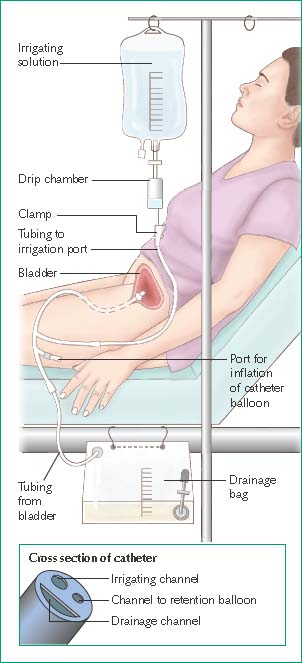Continuous Bladder Irrigation
Continuous bladder irrigation can help prevent urinary tract obstruction by flushing out small blood clots that form after prostate or bladder surgery. It may also be used to treat an irritated, inflamed, or infected bladder lining.
This procedure requires placement of a three-way bladder catheter. One lumen controls balloon inflation, one allows irrigant inflow, and one allows irrigant outflow. The continuous flow of irrigating solution through the bladder creates a mild tamponade that may help prevent venous hemorrhage. (See Setup for continuous bladder irrigation.) Although the catheter is inserted
in the operating room during prostate or bladder surgery, it may also be inserted at bedside.
in the operating room during prostate or bladder surgery, it may also be inserted at bedside.
Setup for Continuous Bladder Irrigation
With continuous bladder irrigation, a three-way catheter allows irrigating solution to flow into the bladder through one lumen and flow out through another, as shown in the inset. The third lumen is used to inflate the balloon that holds the catheter in place.
 |
Unless specified otherwise, the patient should remain on bed rest throughout continuous bladder irrigation.
Equipment
Sterile irrigating solution (usually normal saline solution) ▪ sterile tubing for use with bladder irrigation system ▪ drainage bag and tubing ▪ gloves ▪ antiseptic pad ▪ IV pole.
Normal saline solution is usually prescribed for bladder irrigation after prostate or bladder surgery. Large volumes of irrigating solution are usually required during the first 24 to 48 hours after surgery. If medication solution is ordered, it’s usually prepared by a pharmacist before use.
Preparation of Equipment
Check the solution bag for leakage. If the solution contains an antibiotic, check the patient’s chart to make sure he isn’t allergic to the drug. Make sure that the irrigating solution is at room temperature to prevent bladder spasm.
Implementation
Verify the doctor’s order.
Confirm the patient’s identity using at least two patient identifiers according to your facility’s policy.1
Assemble all equipment at the patient’s bedside.
Provide privacy, explain the procedure, and answer any questions.
Stay updated, free articles. Join our Telegram channel

Full access? Get Clinical Tree


Get Clinical Tree app for offline access
